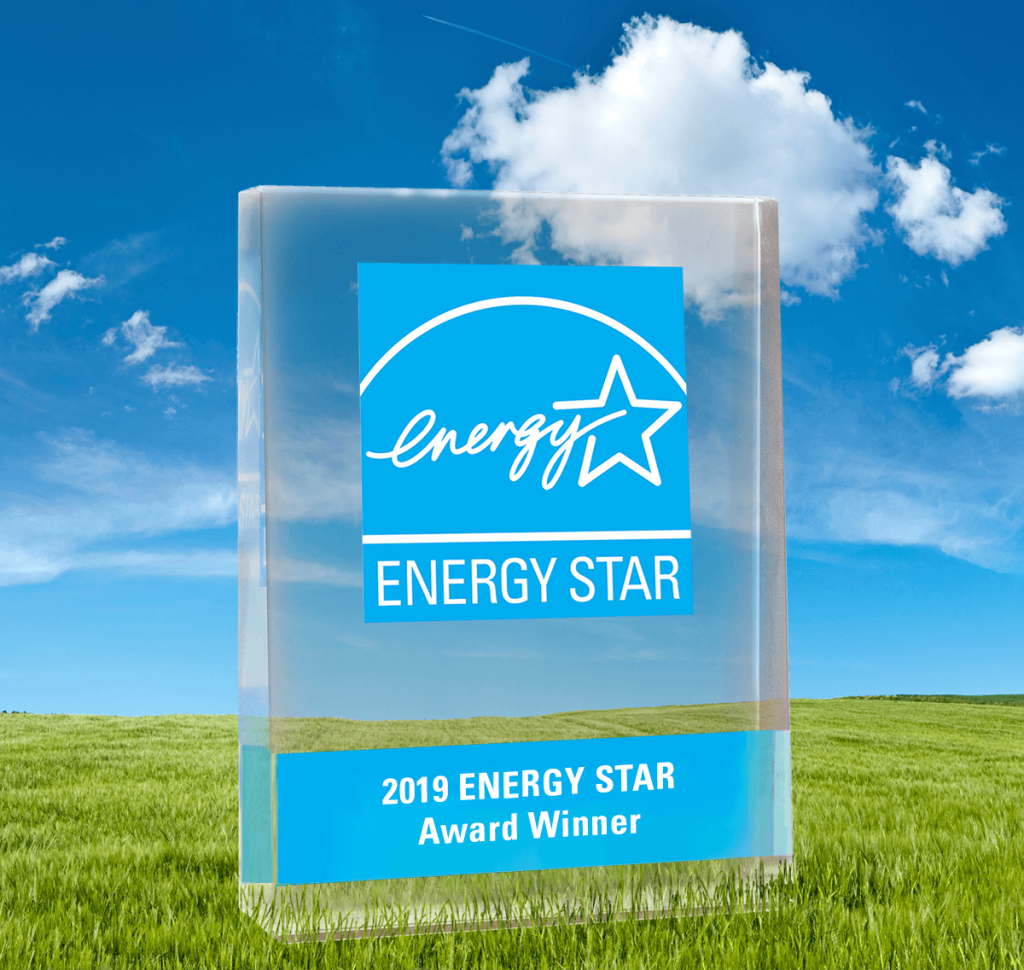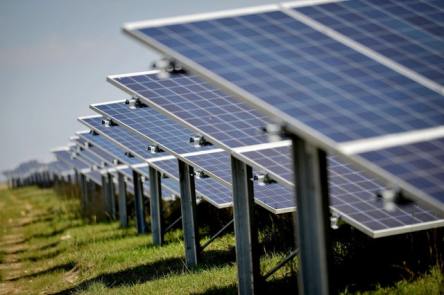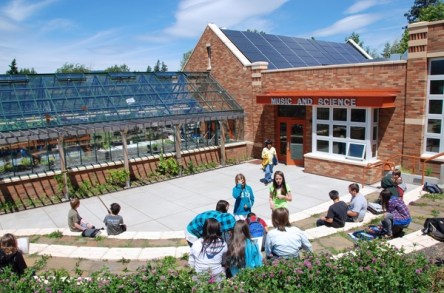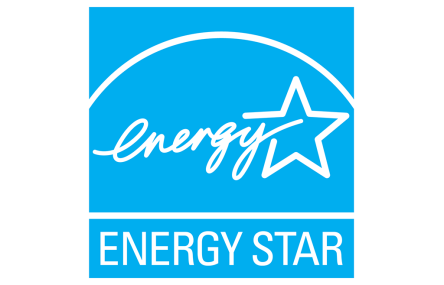Tuesday, Oct. 22, 2019, is ENERGY STAR Day, described by the U.S. Environmental Protection Agency as “a celebration of energy efficiency” and a means to raise awareness of the benefits of favoring products and properties with ENERGY STAR® certification. And there’s a lot to celebrate. On average, ENERGY STAR-certified buildings use 35% less energy than typical buildings nationwide and command a premium of up to 16% for sales prices and rental rates. More than 34,000 buildings have earned certification, which requires an ENERGY STAR score of 75 or higher, meaning that such a building performs better than at least 75% of similar buildings nationwide. All told, ENERGY STAR and its partners have helped save American families and businesses more than $450 billion and over 3.5 trillion kilowatt-hours of electricity since 1992 while also achieving broad emissions reductions. Another facet of the ENERGY STAR program has been similarly fruitful for industrial plants, while ENERGY STAR-certified homes, apartments and products are built to an equally high standard of efficiency. Yardi is intimately familiar with ENERGY STAR and its benefits. Property managers use the Yardi Pulse Suite to capture energy data for ENERGY STAR® benchmarking and reporting. The company employs experts who can help clients identify conservation opportunities and comply with ENERGY STAR and other standards. Yardi is also sponsoring a series of webinars this month on new ENERGY STAR compliance requirements taking effect in the U.S. and Canada next year. The EPA, co-manager of ENERGY STAR, has recognized Yardi as an energy efficiency leader. In April 2019, the company earned designation as an ENERGY STAR Partner of the Year, the highest level of recognition the agency offers, in the service and product provider category. Check out the EPA’s toolkit for spreading awareness of ENERGY STAR Day through...
Standard of Excellence
Energy Star Awards
The U.S. Environmental Protection Agency’s designation of Yardi as a 2019 ENERGY STAR® Award recipient in the service and product provider category was previously announced in this space. The award recognizes the company’s outstanding contributions to protecting the environment through superior energy efficiency achievements. More than 180 organizations across a broad swath of industries joined Yardi in receiving ENERGY STAR awards in April. Some of their achievements that ENERGY STAR documented are summarized below. Along with saving more than 5.6 million kilowatt-hours from LED retrofit and solar programs, Chicago apartment community developer and manager AMLI Residential engaged its leasing staff to educate residents and prospective residents on the benefits of living in an ENERGY STAR-certified community. Boston Properties incorporated cost recovery for ENERGY STAR certification, sub-metering of high-intensity tenant equipment and tenant energy disclosure through ENERGY STAR Portfolio Manager® into its master lease form. The self-administered and self-managed real estate investment trust also achieved ENERGY STAR certification for 77 properties in 2018. Bozzuto Management Company of Greenbelt, Md., pursued 100% benchmarking in ENERGY STAR Portfolio Manager for all managed assets and achieved energy reductions of more than 3% and 2% in site and source energy usage, respectively, across its portfolio in 2017, which equates to a calculated energy cost savings of more than $4 million. The manager of more than 255 multifamily communities also communicates sustainability and ENERGY STAR issues through its internal Bozzuto in the Know program. CommonWealth Partners, a Los Angeles private real estate investment, development, management and operating company, developed an internal Battle of the Buildings Bootcamp competition that focused on empowering properties to reduce energy, water and waste over three months. The effort saved more than 12,000 megawatt-hours of energy, 16,000 kilogallons of water and more than 3,400 metric tons of carbon dioxide equivalent. Fairfax (Va.) County Public Schools, which serves more than 190,000 students, has saved more than $23 million since 2014 through a comprehensive energy program. The 10th largest school division in the U.S. also enacted student-conducted home energy audits, a Battle of the Buildings competition and extensive promotion of ENERGY STAR and energy efficiency through social media. Hudson Pacific Properties, a vertically integrated real estate company in Los Angeles, implemented an engagement and recognition program that recognized properties that achieved the largest ENERGY STAR score improvement, hosted the best tenant engagement event and demonstrated the largest reductions in energy, water and waste usage. Los Angeles-based Kilroy Realty Corporation received ENERGY STAR Charter Tenant recognition for one of its offices and promoted ENERGY STAR in an innovative TEDx talk. It also joined the BOMA W2 challenge, an initiative built with the support of a grant from Yardi, across 84 buildings. LBA Realty LLC achieved ENERGY STAR certification for 21 properties in 2018. The Irvine, Calif. office and industrial property manager and investor also increased its average ENERGY STAR score portfolio-wide from 78 to 81 and reduced its average weather-normalized source energy use intensity by over 5% from 2017-18. Memorial Hermann Health System of Houston saved more than 14 million kilowatt hours by retrofitting light fixtures. It also became the first healthcare system in Texas to utilize new ventilation rate standards that reduce energy use while still meeting air change rates set by the department of health. Principal Real Estate Investors LLC of Des Moines, Iowa, achieved more than 3% reduction in average weather-normalized source energy use intensity from 2017-18. The company has achieved more than $52 million in cumulative avoided energy costs and more than $137 million in potential increased asset value since 2008. Defense, civil government and cybersecurity solutions provider Raytheon Company designed and built an energy-efficient onsite data center that can be replicated at other sites, earning a top project award from its manufacturing peers. The Waltham, Mass.-based company also completed onsite battery storage projects at two facilities that help offset power consumption from the grid during peak periods. SL Green...
CA Benchmarking
Yardi Smart Energy Suite is Ready
A California energy benchmarking law going into effect next June requires multifamily property owners to complete a potentially daunting array of information gathering and reporting requirements. Yardi’s energy management software and experts stand ready to make the process easy and painless. Under the mandate, known as AB 802, owners of multifamily buildings with more than 17 units, or gross floor area of 50,000 square feet, must report information on energy use from all energy meters using ENERGY STAR® Portfolio Manager®. Reports to the California Energy Commission for 2018 are due to the California Energy Commission on June 1, 2019, and annually thereafter. Similar requirements for commercial buildings went to effect in June 2018. Actions the commission recommends to meet the June 1 deadline begin by Feb. 1, 2019. Each building’s energy efficiency will be disclosed on a yet-to-be-established state website. “Publicly disclosing the performance of buildings will allow building owners and tenants to make better informed purchasing and leasing decisions, and the general public to better understand the buildings in which they live and work,” according to the California Energy Commission. Yardi is an ENERGY STAR Partner and is helping California users of the Yardi Smart Energy Suite get ready for AB 802. All owners of more than 330 California properties that rely on Yardi for ENERGY STAR benchmarking have retained the company in preparing for AB 802. Yardi Utility Expense Management, an element of the Yardi Pulse Suite, centralizes utility cost and consumption data and sends it directly into ENERGY STAR Portfolio Manager. Portfolio Manager is an online tool for tracking energy and water consumption and greenhouse gas emissions. It also allows comparisons of a building’s energy performance against similar-type buildings. Elements of AB 802 compliance include setting up multiple measurement criteria for...
Powered by Bacteria
Photovoltaic innovation
The energy industry is reinventing itself in combined efforts to limit as much as possible the effects of climate change. Evermore photovoltaic farms emerge around the world, evermore wind projects spring up onshore, offshore near shore, and even air borne—the industry is still in perfecting mode, new ideas turning into new ways to harvest green energy. There’s one more breakthrough in the solar energy world, coming from the scientists at the University of British Columbia. The Canadian researchers managed to develop a bacteria-powered solar cell that can convert light to energy, regardless of the weather, working as efficiently in dim and bright light, which could be a step forward in places like British Columbia and parts of northern Europe where overcast skies are common. Called biogenic cells, these solar cells made of living organism, are intriguing. This new cell generated a current stronger than any previously recorded from such a device. This is the first time when researchers connected nine biological-solar (bio-solar) cells into a bio-solar panel, in an attempt to replicate photosynthesis—the natural way to convert light energy into chemical energy that is later released to fuel the organism’s activities. Previous endeavors were centered around extracting light-sensitive dye from genetically modified bacteria, but the process proved to be quite costly, complex and also not quite safe as during the extraction process, the dye was often damaged by the solvents used. The Canadian team tried something different—they used E.coli genetically engineered to produce ample amounts of lycopene—the molecule that gives tomatoes their orange-red tint. Now, some of you might startle at the sight of E.coli, but this bacteria was chosen for cloning due to its low mutation and recombination rates. Lycopene is considered an excellent natural dye and is fantastic at harvesting sunlight. Their...
Zeroing In
On Energy Neutral Buildings
It was a different era in 1997, when Portland, Ore.-based New Buildings Institute, a nonprofit organization that promotes energy performance improvements in commercial buildings, was founded. LEED and ENERGY STAR® buildings, Living Buildings, market adoption of renewable energy to any measurable degree—all were yet to come. “Reducing energy use was almost exclusively driven by utility efficiency programs focusing largely on fluorescent lighting upgrades,” NBI reflected recently. Today, At least 50% of customers have the option to purchase renewable electricity directly from their power supplier according to the U.S. Department of Energy. Energy conservation has become considerably more sophisticated in a report NBI recently released to coincide with the organization’s 20th anniversary. While still small in relation to total buildings and floor space, zero building development in the U.S. is accelerating, according to the report. Zero energy buildings—defined by the U.S. Department of Energy as a property or community where “on a source energy basis, the actual annual delivered energy is less than or equal to the on-site renewable exported energy”—are gaining favor across virtually all property types. The recent NBI report, “Getting to Zero Status Update and List of Zero Energy Projects,” highlights nearly 500 zero energy commercial building projects across the U.S. Projects owned by for-profit companies account for 26% of the list. Privately held buildings account for 46% of zero energy buildings, with K-12 schools representing 18%. By contrast, NBI’s first Getting to Zero Status Update in 2012 reported just 60 commercial and multifamily buildings or projects that were either verified as zero energy or approaching that level. Zero energy buildings had the potential to grow in popularity, Greg Zimmerman, executive editor of FacilitiesNet, said in 2010, because they are “the embodiment of sustainability because net-zero is a model that is self-contained—no...
Energy Futures
WEEC 2018 RECAP
The recent World Energy Engineering Congress (WEEC) 2018 in Charlotte, N.C., addressed factors that impact an organization’s energy performance. we asked Christy Cannon, an account executive for Yardi Energy, about her experience at one of the year’s major energy conferences and technology expositions. Christy, what did you gain from the conference? Cannon: The classes are very beneficial to me because it’s a conference by and for energy managers. This is my wheelhouse! I’ve been doing energy management for almost 20 years and attending this conference for almost a decade. I’m also proud that Yardi has supported the Association of Energy Engineers (AEE), presenter of the conference, for years by sending attendees and serving as a corporate sponsor. Q: Why was this year’s WEEC special for Yardi? A: This was the first time Yardi Energy had a booth at WEEC. Also, all nine of our group are certified as energy managers by AEE: Kushal Shah, Rahsan Stewart, Ray Segars, Alex Gonzalez, Arturo Perea, Ankita Gupta, Dan Rice, Dan Cordero and me. When I joined Yardi in 2012 I was the company’s only Certified Energy Manager. The addition of eight CEMs reflects Yardi’s commitment to supporting clients’ energy management and sustainability needs. Q: What were the main takeaways from the conference? A: Presenters outlined three trends to watch for in 2019. One is the evolution of blockchain, whose potential application to the energy industry includes microgrids comprising multiple buildings, each of which having their own generation, that enable peer-to-peer energy trading with no utility involvement. Generation capacity, pricing, and transaction details could be shared with everyone in the microgrid in real time. It also has potential scalability and security advantages. Q: What was the second key trend? A: The role of artificial intelligence (AI) in shaping energy demand management....
Score Alert
New ENERGY STAR Metrics
The U.S. Environmental Protection Agency’s ENERGY STAR® score gives building owners a snapshot of their property’s energy performance by comparing it to a database of similar buildings. Performance metrics in ENERGY STAR Portfolio Manager®, an online tool for tracking energy and water consumption and greenhouse gas emissions, changed on Aug. 26 to reflect the most recent market data available. This update is part of EPA’s standard process to “keep ENERGY STAR metrics as current as possible, and reflective of current market performance,” the agency says. The revised ENERGY STAR criteria incorporate the most recent Commercial Buildings Energy Consumption Survey (CBECS), which constitutes the baseline against which owners compare their buildings to earn certification. In short, the change is an effort to make sure that the “similar building” comparisons for performance are as accurate as possible. EPA continues, “The most recent market data available shows an overall improvement in the energy performance of the U.S. building stock in recent years. So when Portfolio Manager metrics are updated on August 26, ENERGY STAR scores and other performance metrics will, on average, go down.” The new calculations “will be applied across all time periods, which means scores and metrics for all historical benchmarking data will change. By applying this update across all time periods, you’ll continue to be able to analyze changes that are a result of your own activities, rather than changes in underlying market data.” “The change is significant for buildings pursuing LEED or Green Globes certification, for buildings with GSA or other government space leases tied to an ENERGY STAR score of 75, for buildings in cities with mandatory benchmarking, and for the more than 450,000 commercial properties that have an ENERGY STAR score,” says Baltimore environmental attorney Stuart Kaplow, publisher of a green...
Green Lease Leaders
Energy Best Practices
Commercial building owners, tenants and brokers need the right tools to incorporate energy efficiency into leases. A program called Green Lease Leaders stands ready to provide them. Green Lease Leaders helps real estate practitioners create leases that promote collaboration on investments such as high-efficiency rooftop air handling units, lighting retrofits, water irrigation upgrades and solar panels. The program was the subject of a recent webinar, “How to Become a Green Lease Leader: The Latest in High-Performance Leasing Practices and Recognition.” Presenters included Holly Carr, a Department of Energy technology program specialist, Sara Neff, senior vice president of sustainability for Yardi client Kilroy Realty Corporation, and Alexandra Harry, program manager, market engagement for the Institute for Market Transformation (IMT). Green Lease Leaders was developed in 2014 by IMT, a Washington, D.C. nonprofit and the webinar’s host, with support from the Energy Department’s Better Buildings Alliance. IMT works to unlock building energy efficiency that it says could save the U.S. office market $3.3 billion annually and cut energy consumption by 22% in leased buildings. The program currently includes landlords, tenants and brokers who represent 1.3 billion square feet of commercial, industrial and retail space. “Tenants and landlords share an obligation to understand how much energy their buildings use and jointly share the cost of upgrades as well as the resulting maintenance savings and best practices,” Carr said. “Benefits of green leasing include reducing utility bills by up to 51 cents per square foot, increased net operating income, reduced occupancy costs, increased occupant satisfaction, fewer greenhouse gas emissions and improved landlord-tenant communication and relationships.” Along with defining new best practices for energy efficiency in buildings, the program also offers participants technical support, peer networking opportunities, tools for comparing current leases to Green Lease Leaders standards and other...
Return on Energy
Upgrades for Efficiency
Want to cut costs on energy? The National Apartment Association (NAA) Education Conference session entitled Return On Energy: Sustainable Case Studies for Catching Up offered several helpful tips for keeping costs low and residents happy. The session featured Martin Levkus, Regional Director, Yardi Energy; Tom Turnbull, Senior Engineer, JDM Associates; and moderator, Erin Hatcher, LEED Sustainability Manager & Development Associate with AMLI. Hatcher kicked off the session with a question to the audience: “in-house or out-of-house?” Some multifamily owners and operators, like AMLI, have the infrastructure in-house to do their own sustainability and energy efficiency projects. Others, need to outsource to experts if they don’t have the personnel or expertise to do it all themselves. Although both methods have pros and cons, there are some key tips that either method can use to help your properties operate optimally. Data + Analysis = Cost Savings You can’t improve what you can’t measure. Yardi has helped numerous businesses decrease utility expenses with the help of software and Levkus’ advice: “It all starts with a utility bill.” Before you can take down the low hanging fruit, you need to use data to identify it. Levkus referred to a case study including 14,600 units across 260 properties. The organization spent $50,000 – $100,00 in late fees each year. With better bill processing integrated into one software solution, they reduced late fees for roughly $75,000 in annual savings. Beyond paying the utility bills on time, you also want to make sure the bills have accurate charges. A separate Yardi study revealed that for a residential property management business spending $32 million per year on utilities across 63,000 invoices, there were significant billing errors by the utility company equallying $388,000 across two years – 0.55 percent of spend. Yardi’s goal...









